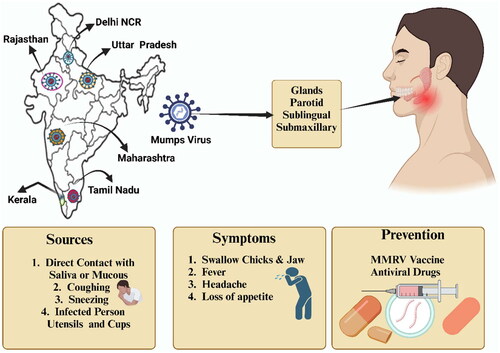Dear Editor,
The recent surge in the cases of mumps, primarily among children being seen in India and its states including Rajasthan, Odisha, Uttar Pradesh, Maharashtra, and Delhi NCR [Citation1]. This letter provides insights into the urgent need for better health infrastructure, enhanced surveillance, vector control measures, community education, improved diagnosis, prenatal care, patient counselling, and collaborative efforts to combat this vulnerable disease, particularly children. Mumps is an acute, highly contagious viral infection caused by a single-stranded RNA paramyxovirus primarily affecting the salivary glands, particularly the parotid glands located beneath the ears, and characterised by its sudden onset with associated inflammation [Citation2]. It spreads through respiratory droplets from coughing or sneezing of infected individuals, and complications may arise, including inflammation of the testicles or ovaries, meningitis, and deafness [Citation3]. Even though mumps virus only one serotype is known, there are 13 genotypes (A to M) of these viruses, which have been determined based on SH protein sequencing that is the most variable proteins among mumps strain viruses [Citation4]. According to the data of the Global Health Observatory (GHO), only India reported 764 cases of mumps during the year 2021–2022, particularly among children, which indicates a substantial burden of mumps and leads to worldwide complexity of mumps resurgence [Citation5]. The increasing number of mumps cases among children in Indian states like Maharashtra, Uttar Pradesh, Odisha, and Rajasthan is a serious concern observed after 4–5 years that raises questions about the factors responsible for disease resurgence in these regions [Citation6]. In the last month of the year 2023, mumps outbreaks in the districts of Kerala Idukki and Palakkad, Sivagangai district in Tamilnadu, Udupi district in Karnataka, and Rajnandgaon district in Chhattisgarh, served as a pitiful reminder of the challenges imposed by this infectious disease. These are mainly among children with the symptom’s inflammation and mild fever [Citation7]. The respective District Rapid Response Teams lead the measures to control these outbreaks through multiple approaches like community health awareness campaigns, door-to-door surveys, and immunisation programs at the district level [Citation8]. There are numerous factors involved in the recent rise of mumps cases in India despite not including mumps vaccine in the routine vaccination program under the Universal Immunisation Programme (UIP) suggested by the World Health Organisation [Citation9]. In India, the MR vaccine is recommended in a two-dose strength for children age group between 9 to 15 months mainly to cover rubella and measles but not mumps. On the other hand, the MMR vaccine in India is only available in the private sector, and over 80% of the children population is deprived of it. Another one of the most important factors for the mumps resurgence in India is the population of naive children and the absence of the mumps vaccine in UIP. Before the vaccination introduction, it was an epidemic disease with 4–5 years of viral cycle [Citation10]. The metanalysis recommended that the waning rate and immunogenicity for the measles, mumps, and rubella components in MMR vaccines suggested that there is a significant improvement in the immunity of the vaccinated individuals [Citation11]. Another factor involved in the improved immunity among the vaccinated people is due to the vaccine and circulating strains alterations, as well as the improper sanitation, mass gathering, and deprivation of healthcare facilities in remote areas may further promote the virus spread [Citation12]. By implementing these recommendations, public health authorities, clinicians, and researchers can contribute to the prevention, early detection, and effective management of mumps infections, ultimately reducing the associated public health risks, especially among children. .
Author contribution
S.R.K, S.S, S.K: Writing original draft, R.M, P.S, A.M: Review and editing, R.S: Conceptualisation, Supervision.
Ethical approval
Not applicable.
Acknowledgement
None
Disclosure statement
No potential conflict of interest was reported by the author(s).
Additional information
Funding
References
- India Today. December 21, 2023: Clarance D. Mumps cases rise among children: experts reveal why. Accessed on January 11, 2024. Available from: https://www.indiatoday.in/ health/story/mumps-cases-rise-among-children-expertsreveal-why-2478991-2023-12-21.
- Hamborsky J, Kroger A, Wolfe C, editors. Epidemiology and prevention of vaccine-preventable diseases: the pink book: course textbook. Public Health Foundation; 2015.
- Centers for Disease Control, Prevention (US), National Immunization Program (Centers for Disease Control, Prevention), National Immunization Program (Centers for Disease Control, Prevention). Education, Information, Partnership Branch. Epidemiology and prevention of vaccine-preventable diseases. Department of Health & Human Services, Public Health Service, Centers for Disease Control. and Prevention; 2005.
- Litman N, Baum SG. Mumps virus. In: bennett JE, Dolin R, Blaser MJ, Douglas M (Eds). Bennett’s principles and practice of infectious diseases., Eighth Edition. WB Saunders, 2015, pp 1942–1947.
- World Health Organization. Global Health Observatory Data Repository. Mumps - Reported cases by country. Accessed on January 11, 2024. Available from: https://apps.who.int/gho/data/view.main.1540_53.
- Integrated Disease Surveillance Programme. Weekly outbreaks. Accessed on January 11, 2024. Available from: https://idsp.mohfw.gov.in/index4.php?lang=1&level=0&.linkid=406&lid=3689
- India.com., December 23, 2023. Mumps outbreak in India: symptoms and precautions to protect your kids from this deadly virus. Accessed on January 11, 2024. Available from: https://www.india.com/health/mumps-outbreak-in-indiasymptoms-.and-precautions-to-protect-your-kids-from-thisdeadly-virus-6606668/.
- Hindustan Times. November 14, 2023: Pal S. Mumps outbreak in Mumbai’s poorer areas causes worry. Accessed on January 11, 2024. Available from: https://www.hindustantimes.com/cities/mumbai-news/mumps-outbreak-in-mumbai-spoorer-.areas-causes-worry-101699902457945.html.
- World Health Organization. Mumps virus vaccines: WHO position paper. Weekly Epidemiological Record No. 2007;82(7):51–60. Accessed on January 11, 2024. Available from: https://www.who.int/publications-detail-redirect/WHOWER8207-51-60
- Vaidya SR, Hamde VS. Is it the right time to introduce the mumps vaccine in India’s universal immunization program? Indian Pediatr. 2016 Jun;53(6):469–473. doi: 10.1007/s13312-016-0874-4.
- Schenk J, Abrams S, Theeten H, et al. Immunogenicity and persistence of trivalent measles, mumps, and rubella vaccines: a systematic review and meta-analysis. Lancet Infect Dis. 2021 Feb 1;21(2):286–295. doi: 10.1016/S1473-3099(20)30442-4.
- Hiebert J, Saboui M, Frost JR, et al. Mumps resurgence in a highly vaccinated population: insights gained from surveillance in Canada, 2002–2020. Vaccine. 2023 Jun 7;41(25):3728–3739. doi: 10.1016/j.vaccine.2023.04.078.

